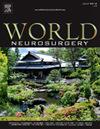Structural allograft versus Polyetheretherketone cage in Anterior Cervical Discectomy and Fusion: A Meta-analysis.
IF 1.9
4区 医学
Q3 CLINICAL NEUROLOGY
引用次数: 0
Abstract
BACKGROUND Polyetheretherketone (PEEK) cages and structural allografts (SAs) are commonly used in Anterior Cervical Discectomy and Fusion (ACDF), yet their postoperative results remain uncertain. This meta-analysis was conducted to determine whether there were any differences in outcomes between patients who received these two grafts in ACDF. METHODS We comprehensively searched electronic databases up to August 2023. Observational studies or randomized controlled trials reported postoperative outcomes, including fusion, subsidence, reoperation rates, and patient-reported outcomes through the Neck Disability Index (NDI), the Visual Analog Scale (VAS) for neck and arm pain, and the Japanese Orthopedic Association (JOA)/modified JOA score following primary ACDF using SA or PEEK cage. The results are presented in odds ratios (ORs) or mean differences with corresponding 95% confidence intervals (CIs). RESULTS Eleven studies were included, with 1213 patients (788 receiving SAs and 425 receiving PEEK cages). Patients having SA had significantly higher fusion (OR: 1.84, 95% CI: 1.27-2.67, p = 0.001) and lower subsidence (OR: 0.50, 95%CI: 0.30-0.86, p = 0.01) rates when compared with the PEEK cage. There was no difference in revision rate between SA or PEEK cage (p = 0.88). Two grafts demonstrated similar clinical improvements in NDI (p = 0.31), VAS for the neck (p = 0.77) and arm pain (p = 0.22), and JOA/mJOA score (p = 0.99). CONCLUSION SA demonstrates better fusion and lower subsidence rates than the PEEK cage in ACDF. Nevertheless, these two cages resulted in equally successful postoperative clinical performances.颈椎前路椎间盘切除和融合术中的结构性同种异体移植物与聚醚醚酮笼:一项 Meta 分析。
背景聚醚醚酮(PEEK)固定架和结构性同种异体移植物(SA)常用于颈椎前路椎间盘切除与融合术(ACDF),但其术后效果仍不确定。本荟萃分析旨在确定在 ACDF 中接受这两种移植物的患者的疗效是否存在差异。观察性研究或随机对照试验报告了使用 SA 或 PEEK 骨架进行初级 ACDF 后的术后结果,包括融合、下沉、再手术率,以及患者通过颈部残疾指数(NDI)、颈部和手臂疼痛视觉模拟量表(VAS)和日本骨科协会(JOA)/修正 JOA 评分报告的结果。结果共纳入 7 项研究,1213 例患者(788 例接受 SA,425 例接受 PEEK 骨架)。与 PEEK 骨架相比,使用 SA 骨架的患者融合率明显更高(OR:1.84,95% CI:1.27-2.67,p = 0.001),下沉率明显更低(OR:0.50,95% CI:0.30-0.86,p = 0.01)。SA 和 PEEK 骨架的翻修率没有差异(p = 0.88)。两种移植物在 NDI(p = 0.31)、颈部疼痛 VAS(p = 0.77)和手臂疼痛 VAS(p = 0.22)以及 JOA/mJOA 评分(p = 0.99)方面都有相似的临床改善。尽管如此,这两种骨架的术后临床表现同样成功。
本文章由计算机程序翻译,如有差异,请以英文原文为准。
求助全文
约1分钟内获得全文
求助全文
来源期刊

World neurosurgery
CLINICAL NEUROLOGY-SURGERY
CiteScore
3.90
自引率
15.00%
发文量
1765
审稿时长
47 days
期刊介绍:
World Neurosurgery has an open access mirror journal World Neurosurgery: X, sharing the same aims and scope, editorial team, submission system and rigorous peer review.
The journal''s mission is to:
-To provide a first-class international forum and a 2-way conduit for dialogue that is relevant to neurosurgeons and providers who care for neurosurgery patients. The categories of the exchanged information include clinical and basic science, as well as global information that provide social, political, educational, economic, cultural or societal insights and knowledge that are of significance and relevance to worldwide neurosurgery patient care.
-To act as a primary intellectual catalyst for the stimulation of creativity, the creation of new knowledge, and the enhancement of quality neurosurgical care worldwide.
-To provide a forum for communication that enriches the lives of all neurosurgeons and their colleagues; and, in so doing, enriches the lives of their patients.
Topics to be addressed in World Neurosurgery include: EDUCATION, ECONOMICS, RESEARCH, POLITICS, HISTORY, CULTURE, CLINICAL SCIENCE, LABORATORY SCIENCE, TECHNOLOGY, OPERATIVE TECHNIQUES, CLINICAL IMAGES, VIDEOS
 求助内容:
求助内容: 应助结果提醒方式:
应助结果提醒方式:


